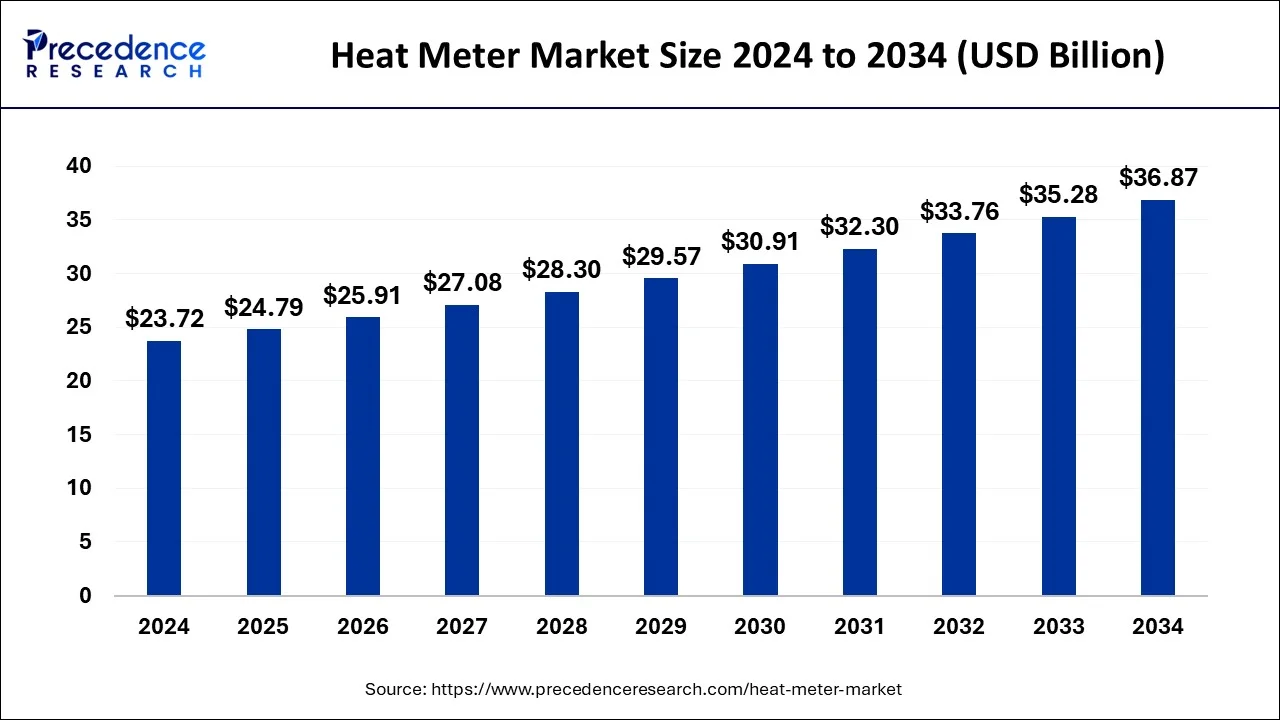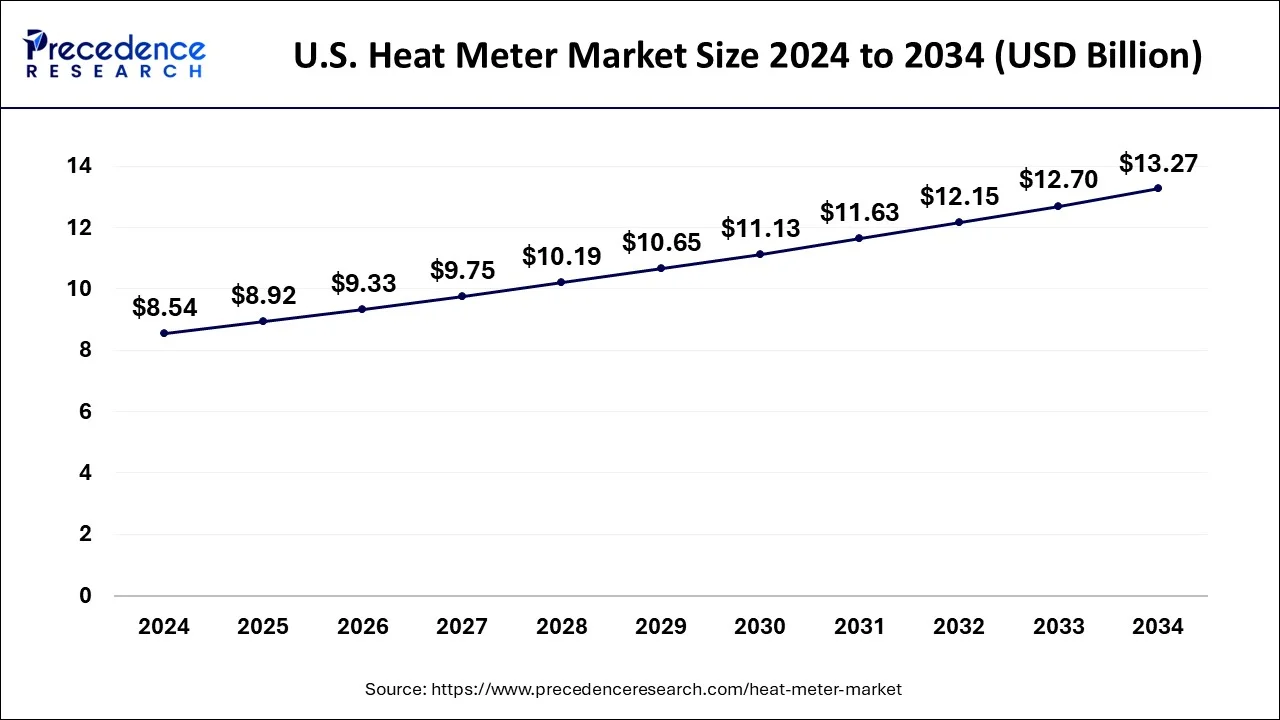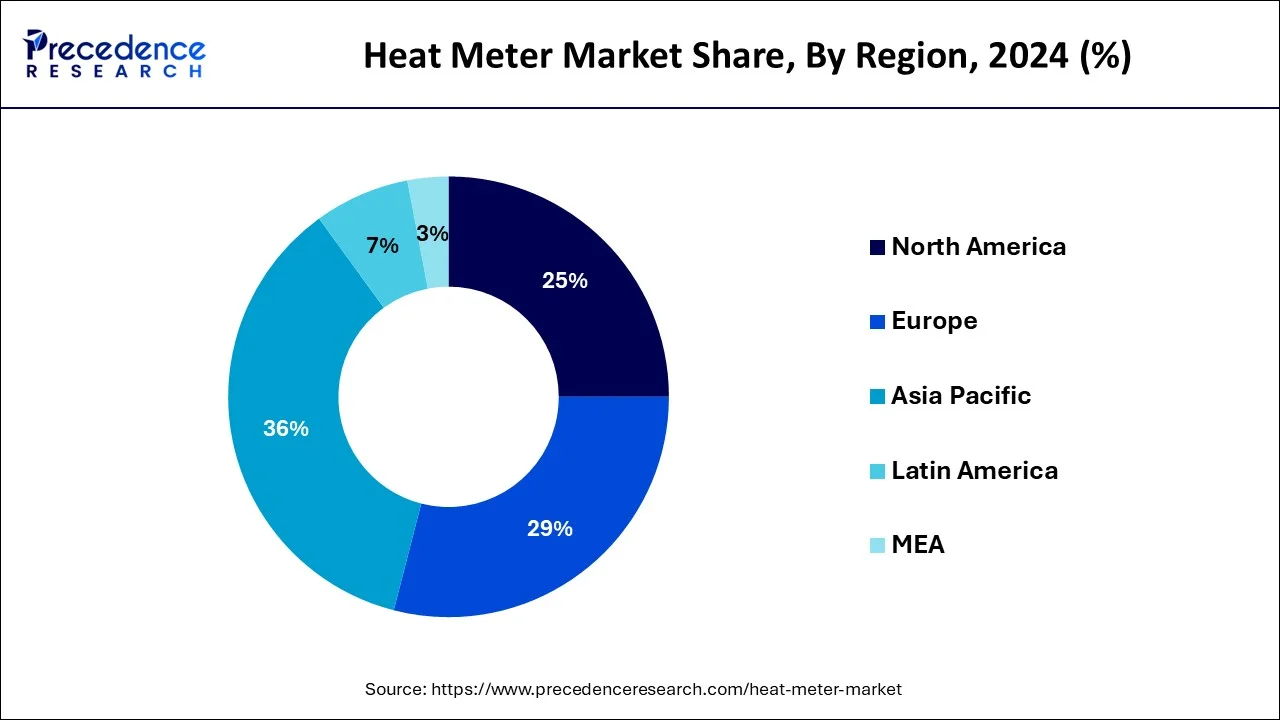May 2025
The global heat meter market size accounted for USD 1.71 billion in 2025 and is forecasted to reach around USD 3.10 billion by 2034, accelerating at a CAGR of 6.83% from 2025 to 2034. The North America heat meter market size surpassed USD 560 million in 2024 and is expanding at a CAGR of 6.88% during the forecast period. The market sizing and forecasts are revenue-based (USD Million/Billion), with 2024 as the base year.
The global heat meter market size was exhibited at USD 1.60 billion in 2024 and is anticipated to reach around USD 3.10 billion by 2034, expanding at a CAGR of 6.83% from 2025 to 2034. The rising energy costs, infrastructure development, and government policies to promote heat meters drive the market's growth.

Integration of artificial intelligence (AI) is revolutionizing the energy sector. AI algorithms improve the accuracy of heat meters by analyzing data. AI led to the development of smart meters, which are rapidly gaining traction. These advanced devices provide real-time data on energy consumption, which is invaluable for various stakeholders, including consumers, energy suppliers, and grid operators. Smart meters facilitate a comprehensive analysis of energy usage over time and across different demographics by capturing and transmitting precise information about how energy is utilized in homes and businesses. This data empowers consumers to make informed decisions about their energy consumption, potentially leading to reduced bills and more efficient energy use. Insights from this data enable suppliers to forecast demand, optimize energy distribution, and improve customer service by addressing individual consumer needs.
Smart meters play a critical role in grid management. The real-time data analysis by AI allows grid operators to monitor system performance and identify inefficiencies or potential disruptions in the supply chain. This capability is essential for implementing AI-driven solutions to optimize energy distribution, enhance grid reliability, and minimize outages. Moreover, the information from smart meters supports the broader transition to a low-carbon economy. By analyzing energy consumption trends, AI applications can identify opportunities for energy savings, promote the integration of renewable energy sources, and encourage the adoption of more sustainable practices among consumers. This data-driven approach not only helps in reducing operational costs for energy providers but also aligns with the global imperative to combat climate change by fostering more efficient energy consumption.
The U.S. heat meter market size was evaluated at USD 420 million in 2024 and is predicted to be worth around USD 820 million by 2034, rising at a CAGR of 6.91% from 2025 to 2034.

North America is Estimated to be the Largest Market for Heat Meter
The comprehensive research account covers substantial projections and inclinations of heat meter throughout chief regions encompassing Africa, Asia Pacific, Europe, Latin America, North America, and Middle East.By region, North America led the global heat meter market with the highest market share of 35% in 2024, Europe is projected to advance at top-most CAGR predominantly due to high demand from new markets such as Turkey, Russia, and Germany. African, South America, and Middle Eastern region is expected to exhibit note-worthy growth in the projected time-frame.
Government policies emphasize the use of heat meters, and they aim to reduce carbon emissions. Technological advancements such as wireless connectivity and data analytics have driven the market growth. In addition, increased use of smart meters bolstered the market in the region. In a study, Berg Insight reports that at the end of 2023, the overall penetration in North America surpassed 80%, with 130.6 million smart electricity meters in the U.S. and 15.4 million in Canada.

The European heat meter market is significantly expanding owing to the growing awareness about energy efficiency and stringent regulations for the conservation of energy. Countries in the European region are increasingly adopting heat metering systems to strengthen energy management and improve accuracy in the billing process. Moreover, government are also promoting renewable energy usage and encouraging people to adopt district heating systems are some of the major growth factors for the heat meter market in the European region.
The Asia Pacific heat meter market is expanding rapidly due to growing industrial heating requirements for various reasons. According to the international energy agency, China has been the largest heat consumer in the past decade. Additionally, increasing industrialization in developing countries like India and Japan are contributing to the expansion of the heat meters market in the Asia.
Mandatory regulations in some countries that require installation of heat meters have turned out to be a major driver for the progress of the worldwide heat meter market. Moreover, administrations around the world are developing guidelines to encourage the usage of energy conservation, because of energy import carried out in numerous developing economies.
The European Union member nations are mandated to have a nationwide regulation grounded on the EED 2012, that implies the setting up of measurement equipment’s for separate apartment billing. Furthermore, heat meter equipment’s must be included inside several schemes for new structure and renovation of area heating networks conforming with EU standards in the immediate future, with Poland, Denmark,and France providing some of the biggest volumes for heat meter consignments.
In other nations, regulatory modification is currently taking effect. For instance, in Russia all big structures on the district heating array must contain a hub (district) meter connected. The Canadian market has observed increased demand for sub-metering thermal energy and seems to be adhering to endorsements from organizations like The Pacific Institute for Climate Solutions which has suggested thermal sub-metering as a way to accomplish energy management and cost regulation.
The technological advancement has today changed the entire usability of heat meters. There are smart heat meters with billing meters designed to offer landlords and service providers a reliable, cost-effective and secure metering solution. This brings the customer a feature-rich and intuitive system which provides information to make informed decision in their energy usage. The credit billing mode and pre-payment mode options are the features among them which indirectly enable the consumer to increase their saving by heat conservation.
| Report Highlights | Details |
| Growth Rate from 2025 to 2034 | CAGR of 7.30% |
| Market Size in 2024 | USD 1.60 Billion |
| Market Size in 2025 | USD 3.10 Billion |
| Market Size by 2034 | USD 2.01 Billion |
| Base Year | 2024 |
| Forecast Period | 2025 to 2034 |
| Segments Covered | Type, Connectivity, Technology, Application and Region |
| Regional Scope | North America, Europe, Asia Pacific, Latin America, Middle East & Africa (MEA) |
Ultrasonic Meters Segment Reported Foremost Market Stake in 2024
The ultrasonic meters segment has held the largest revenue share in 2024. High durability and accuracy of the ultrasonic meters are expected to boost the growth of the segment in the near future. Vortex Meters are expected to grow at highest CAGR within the forecast time-duration.
Static Segment Dominated the Market Revenue By Technology in 2024
The static segment has held the highest market share in 2024, in the target industry due to increasing demand for combined cooling and heating applications.
Residential Segment Will Dominate the Heat Meter Market Revenue By Application
Factors such as rapidly increasing demand for home automation systems are driving growth of the segment. Industrial segment is expected to grow at highest CAGR within the forecast time-duration.
Heat meters find extensive applications in heating and cooling systems used in various industries. Heat meters offer precise and efficient measurement solutions for complex infrastructures.
A future opportunity that the heat meters market holds is the integration of IoT systems with heat meters, which provide remote monitoring and predictive maintenance along with data analytics.
Over the past years, renewable energy sources like geothermal energy and solar thermal energy have seen a notable surge across the globe as a preferable choice for energy generation. Here, heat meters can play a crucial role by measuring precise energy readings and keeping its track record holds significant opportunity for the future market.
The companies focusing on research and development are expected to lead the global heat meter market. Leading competitors contending in global heat meter market are as follows:
By Type
By Connectivity
By Technology
By Application
By Region
For inquiries regarding discounts, bulk purchases, or customization requests, please contact us at sales@precedenceresearch.com
No cookie-cutter, only authentic analysis – take the 1st step to become a Precedence Research client
May 2025